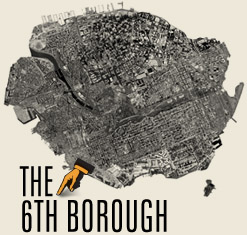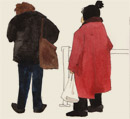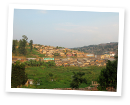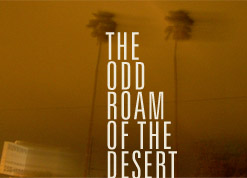
Photograph by Robert Scott Wildes
by LOGAN ANTILL
I grew up in the Phoenix desert. Power lines, palm trees, outdoor schools, enormous streets, monsoons. Vast expanses city. The need for a car was absolute. The sheer amount of space a person must cover to move from one place to the next in Phoenix has an undeniable effect on the Phoenician sense of neighborhood, as does the biblical pull of the desert. I will explain in four parts.
Roads
Although wide, smooth, and grid-mapped, roads in Phoenix are more a thing of separation than connection. Since the city is too sprawled for anyone, other than the poor or mentally unsound, to walk anywhere, all travel depends on cars. Each family owns several cars. The cars are usually large and seem feral, breeding at Chevron stations, in the parking lots of stadium supermarkets.
Because of the immense, static heat, which is almost ever-present in the Arizona desert, driving in Phoenix is roughly equivalent to a pilgrimage across the Thar or Sinai deserts. Cars lurch, plastic melting in the sun, internal motors seize and fans melt. Radiators absolutely explode. The streets are green with boiling coolant.
Those who can afford it go from air-conditioned homes (always central air — there is no other kind of cooling in Phoenix), to air-conditioned garages, to air-conditioned cars, to covered parking garages, to chilly elevators that open into air-conditioned offices. Pedestrians never have the right-of-way.



Residential
The considerable amount of time it takes to navigate traffic, freeways, and road construction (a continuous process to accommodate Phoenix’s unchecked expansion) has encouraged Phoenix to develop into a series of small towns instead of a unified urban area.
Nowhere is this more apparent than in the effusion of new housing developments which have become so prolific they seem to usurp all colors but beige, a condition of the land itself. Unchecked by restraints on space or capital, developers have built self-contained satellite cities in the desert surrounding Phoenix to minimize the time residents spend commuting. Ten years ago the people who moved to these outposts were pioneers, commuting 90 minutes each way to work in central Phoenix. Today, these developments are increasingly built to house the employees of a corporation making inroads in Arizona. People living in these developments may never even venture into Phoenix proper. They have no need to. Everything is there in the new development: schools, outlet malls, water parks, golf, bowling, churches, the multiplex.
You pass them driving on the 1-10 west or 1-17 north, humped along the tips of highway exits bearing their names — Anthem, Tramanto, Aviano, Treviso — vaguely patriotic, yet tinged with an homage to conquered peoples. To call them residential doesn’t seem right. They are luxury outposts at the end of a centuries-old notion of imperialism. They do not harmonize with the desert; they only wait to be filled with the bodies of strangers so that you might drive to California and never lose sight of street lights.
Coyotes venture to the edge of pool fences.



Downtown
There is a constant push in central Phoenix to try to make the city feel urban — all conveniences within walking distance, superb public transportation, bicycle culture. At the end of the 20th century, Phoenix began declaring any block with houses at least 50 years old “historic.” Each historic district received a historic name — Willow District, Garfield, Encanto, FQ Story — as if the knowledge that you were passing from one name into the next would make the distance feel shorter. Supposedly, in historic districts citizens would walk more and host open houses at Christmas time.
But Phoenix does not feel urban, and it likely never will. This is because the people who live in Phoenix do not want it to be. While it may be fashionable for Phoenicians to say they are against urban sprawl, that Phoenix should build “up instead of out,” few people living in Phoenix really care about these things. Phoenix is a resort town. It is a land of over-watered golf courses, failed recycling initiatives — a place people come to because they want to spread out, be left alone, and forget the grim Eastern continent.
The most deluded attempt at connecting downtown Phoenix with adjacent cities like Glendale and Tempe is the construction of the Light Rail Transit System, an above-ground train similar to the relic which orbits Los Angeles, giving the homeless a bright place to sleep at night.
Light Rail construction has kept downtown Phoenix streets in general ruin for several years now. When it is completed the only people who will ride the train will be the people who do not have cars, which is to say, the same people who walk the streets: the hopeless, poor, confused, heat-stroked.
You don’t move to Phoenix because you like to be near other people. You move to a desert city like Phoenix to engage humanity on your own terms, if at all. That a downtown has failed to congeal in Phoenix, and likewise any classic sense of “neighborhood,” is inherent in the city’s longitude and latitude. The thrill of an isolate survival belongs to desert peoples.
Phoenicians do not want more skyscrapers; they want to see the mountains. The name of the international airport is Sky Harbor.



Commercial
In the entire world I have never seen parking lots as large as the asphalt tarmacs that surround Phoenix’s commercial zones.
The parking lot where I learned to drive a car belongs to North Phoenix Baptist Church, a mega church roughly twenty acres large. The parking lot would be an excellent place for a panicked pilot to land a 747 and still have room to taxi.
Often a developer will zone and build the parking lots before knowing which businesses will fill the surrounding strip mall or what attendance will be like on Sunday morning. If God and Labor Day both fail to attract business, the parking lot sits empty — 12 cars in a space built for 1,200.
Since cars eliminate chance encounters with neighbors on the way to the store, parking lots become the place to see your Kindergarten teacher, the man who gave you your first job.
These encounters, however serendipitous, generally fail to yield a social interaction beyond the parking lot. In order to actually spend time together one of you would have to follow the other in your car to another parking lot (there would likely not be anywhere decent to sit and talk near the first parking lot). Or, if you rode together to a restaurant, you would have to get a ride back to the first parking lot to retrieve your car. Phoenicians are forced to think in these terms because they are a desert people, and in the desert, to momentarily lapse into friendship or sympathy, could cost you your life.
The interior space of stores and restaurants mimics the sprawling external city-space. Restaurants seat hundreds. Even if you saw someone you knew at a restaurant the task of actually getting up from your table and crossing the physical space to say hello would be too daunting to attempt.
The anticipation of going out to eat and recognizing an acquaintance across the room is horrible enough to make most Phoenicians intentionally unobservant in crowded commercial spaces. If recognition does occur, mouthing “How are you?” or denial are both socially acceptable.



To live in Phoenix requires a certain individualism and sense of adventure not related to toughness or wit. Many of the people who live there have sought out Phoenix. At its most extreme the spirit of someone who chooses to live in Phoenix resembles the desert-bound Sufi staring at the sun as the solar eclipse approaches, joyously expecting the revelation of a deep and personal secret.
To a Phoenician there is no sense of neighborhood identity. There is only large-scale place recognition. Either you can survive in the desert or you can’t. This idea belongs to the Hebrew Scriptures, frog rain and blood water. Purification, chrysalis.
You can recognize Phoenicians as the ones who are not tan; they have learned the strength of the sun.








